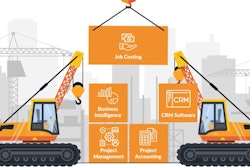
More than in most industries, construction contractors are dependent on others to deliver value, so greater coordination, collaboration, alignment and visibility are essential to on-time delivery and project quality.
Other industries, including project- and program-based manufacturing, have gone further and faster towards connecting supply chain collaborators using tools like electronic digital interchange (EDI), which standardizes digital transactional signals going up and down the supply chain. Various proprietary software tools may help companies facilitate EDI transactions with trading partners, but this is made easier by the existence of the United Nations/Electronic Data Interchange for Administration, Commerce and Transport (UN/EDIFACT) standard. This standard was merged with the United States-focused American National Standards Institute EDI proposal to make up the International Organization for Standardization ISO 9735 standard.
There is nothing like that in construction. So that means software vendors, project owners, engineers, architects and contractors are on their own. This may be slowing down efficiency gains and digitization of the processes that flow between these parties, but what the industry lacks in formal standards it could make up for through entrepreneurial zeal among software companies.
 The transaction between construction project collaborators that causes the most disruption, according to a recent study sponsored by Trimble, is the project change order.Trimble, Dodge Construction Network
The transaction between construction project collaborators that causes the most disruption, according to a recent study sponsored by Trimble, is the project change order.Trimble, Dodge Construction Network
A Change Order Standard?
The transaction between construction project collaborators that causes the most disruption, according to a recent study sponsored by Trimble, is the project change order. That is why growth at Extracker, a software company specializing in streamlining change order processes between owners, generals and subcontractors is so interesting. The company, launched in the middle of 2018, has about 1,900 companies using a free version of the software and 150 paying customers as of our debriefing call in February of 2022. The format or structure of the change order, built around labor, materials, and equipment, is fairly standard and not proprietary to Extracker—their secret sauce is the common digital utility used to share the information between project partners.
One feature Extracker introduced to the industry is the concept of a centralized change order register for a project with a shareable link. This enables subcontractors to track change orders internally but also collaboratively with the general contractor or even the owner.
“Our mission is to become the industry standard for how change orders are shared in commercial construction,” Extractor CEO Cameron Page said. “As it is today, to keep track of change order requests, people download a PDF log back and forth via email to keep track of what has been sent and what has been approved on the project. The sub can send the general a link to the change order log that updates in real time. Whenever the general wants to see their change order exposure from that one sub, they simply click on the link.”
One other innovation from Extracker that helps standardize the way change order transactions are shared is the digital time and materials tag. There are some other companies like Raken that offer this now, but in the form of a field productivity solution. It is in that setting bundled with daily reports, timecards and health and safety reports. But in Extracker, a time and materials tag is used to capture extra work done on the job site, introducing that into the approvals workflow with the general.
Generals can also require their subs to use the Extracker mobile app to capture time and materials tags so change order exposures are immediately logged and to use Extracker to convert those tags to change order requests. This clarity of communication can all flow up to a project owner or from a subcontractor to various subs they in turn have working to deliver parts of their own scope.
Inter-Company Project Information Management
While Extracker aims to become the industry standard for change orders, Newforma envisions itself as a standard for document sharing across multi-year projects. The company’s core product, Newforma, acts as a cross-organization document management and indexing system to provide a common view of documents and revisions often across a years-long project. The tool is primarily used by architecture and engineering firms, but Newforma also has a cloud-based product called ConstructEx that performs similar functions for contractors.
“We stay pretty focused on the design side of things,” Newforma Chief Marketing and Product Officer Slater Latour said. “Looking 10 years out, you will see use cases in BIM expanding—that is something we always focus on. When you look at our split between use cases in building versus civil construction, probably buildings will be the majority. But with the number of customers we have, you have almost every flavor including those doing both civil and building construction.”
Newforma’s killer app may be its project search capability that connects across the project team to various places project documents are stored.
“We connect to all the different places any given customer will have files stored—BIM360, their local file server, cloud-based file locations, and create an index of all those file locations and make that searchable,” Latour said. “In a single search bar, you can see a document related to a project from any source. You are not really moving those files, they can sit right where they are supposed to. We will just search them and let the user share that information with external or internal stakeholders. They can conduct a markup session on those files or initiate any number of workflows.”
This is in contrast to how documents are normally shared in a complex project—through disconnected email threads. Newforma takes into account, however, the fact that email is not going away as a communication medium any time soon.
“We have an Outlook connector that files an email into the official project record and sits along with the other data—all searchable,” Latour said. “The software uses optical character recognition (OCR) to index even static documents including PDFs. The user needs to manually file the email to the project, but from there the software is smart enough to file follow-up emails to the same project. A customer can also create a dedicated email address that similarly automatically addends emails to the relevant project documentation.”
Newforma also provides a viewer for CAD files so those without the appropriate software license can view them. BIM models can also be accessed using Newforma, and comments by those without direct access can later be added to the tables underlying the model. A separate activity center captures as-built updates from contractors.
Latour stresses that the ability of the Newforma application to access data in on-premise as well as cloud-based sources is important given the heavy reliance of the industry on legacy on-premise software. The company has worked with integration firm Ryvit to tunnel into many different solutions used in the industry.
“Our customers will have cloud-based applications, on-premise applications, and data stored in all of those places depending on the needs of the project,” Latour said, adding that the long timeline of projects will make it hard for many architecture and engineering organizations to cycle off on-premise solutions as it would disrupt project operations. “The beauty of Proforma is that we can search in both places.”
Just as Gartner opines that various industries will become more reliant on composable platforms—myriad integrated and interchangeable point solutions rather than broad enterprise solutions—Latour said this reliance on on-premise tools means composability will be even more important in construction, making integration and the ability to cross boundaries across solutions essential.
“As people use more point solutions, we will connect to them all and expand what we can do,” Latour said. “I think we’ll see firms eventually go 100 percent cloud stack, but it will be a much slower evolution on average than other industries.”
Construction Software Integration as a Service
Newforma is not the only company working with Ryvit to integrate with various other software products. While Ryvit will help software vendors like Newforma with integrations, they also make those integrations available as part of an integration network—essentially a Rosetta Stone that translates data across multiple application stacks.
“We work with Ryvit to connect with Procore’s RFI and synch it with ours,” Latour said. “It can automate exchange of RFIs and submittals between our system, which is predominantly used by the architecture and engineering side, and systems like Procore which is used by contractors. So if you are sending a submittal from Procore, it automatically shows up on the architecture side. They can review and respond, and it will automatically synch back to the contractor side.”
Ryvit solves a number of problems for contractors intent on participating in digital workflows with external parties, including the fact that many software solutions used in the sector were developed to run on premise. The company offers an integration platform-as-a-service (iPaaS) product that enables a software vendor to develop an integration against their standard application programming interface (API) to facilitate integrations with any number of other software vendors. This speeds the process of the construction industry towards open integration while giving contractors the ability to license a single iPaaS tool to tie their various internal tools together, or connect processes digitally with tools used by project collaborators.
Ryvit is aggressively pursuing new software vendors to join the fold, and currently connects dozens of software products for among other things asset management, change order management, compliance, ERP, expense management, customer relationship management (CRM), service management, field productivity and time tracking.
“The most obvious problem we solve is the lack of connectivity,” Ryvit COO Angie Licata said. “There are four major ERPs that dominate the space—Vista (formerly Viewpoint) and Spectrum (formerly Dexter+Cheney) are owned by Trimble. Then there are Sage 100 and Sage 300—they are both SQL stack ERPs that run on-premise. None of them, with the exception of some hacky XML APIs in Sage 100, have a full robust restful modern API.”
This legacy software model makes it harder to connect ERP and other software with other products used outside the office like field service and field reporting, and certainly prevents easy bidirectional integration with cloud and on-premise applications used by trading partners on a project.
While cloud-native applications like Sage Intacct, Netsuite, Accumatica and others will have APIs available to integrate with, this alone will not make Ryvit less important in the industry.
“Access is definitely one of the things we provide,” Ryvit CTO Chris Collins said. “But all these ERPs are highly configurable, and each customer’s instance can be different. A restful API for an ERP does not fully empower another product. Professional services are still required because without skill, integrations are risky. The industry at large does not have IT departments. They lean on their software providers to integrate to one another. But the software vendors know their software very well but not others. We know best practices for connecting various solutions and have the expertise and position to want to connect those two software packages.”
Contractors with access to the Ryvit iPaaS application can purchase multiple additional software products and enjoy pre-built integrations configurable in a low-code environment. There is a network effect as value builds for end users and for software companies as more and more software products build a standard API that interfaces with Ryvit.
“The idealistic view is that the ERP is no longer the center of the hub, and potentially Ryvit can be,” Licata said. “Where the ERP used to be the central thing everything would integrate through, you don’t necessarily rely on the ERP as the center node anymore because you’ve got Ryvit as your data hub.”
For contractors, Ryvit aligns pricing strategy with how their software partners charge for their software—per user per per transaction, for instance. The cost to contractors for access to Ryvit’s iPaaS network is negotiated between Ryvit and each software vendor, and then the software vendor sets pricing for its customers. In some cases, some costs of the Ryvit application are passed onto the software company’s customer, and in some cases none of it is. Ryvit does have enterprise customers with a significant number of users, and they may have unique workflows created for them. Very large footprints in the Ryvit iPaaS network may also trigger a direct relationship with Ryvit and potentially volume discounts, but that is the exception rather than the rule as pricing tends to flow through software companies and when this is not the case there is often a separate statement of work.
In time, Licata said the ambition is to achieve the level of sophistication that integration providers like Boomi offer to broader industry while still addressing the unique needs of the construction sector.




















